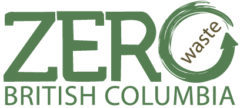Click on the questions below to learn more or see our PDF here. Only have two minutes -see our short two pager here.
1 What is Incineration and Waste to Energy?
Incinerators are facilities that treat waste (materials disposed as garbage) by burning it. They come under many names such as mass burn incinerators, thermal treatment facilities, or waste-to-energy plants, and involve processes such as combustion, pyrolysis, gasification, or plasma arc. They all use high thermal temperatures to burn or alter materials so are also sometimes called “thermal treatment”.
The industry often creates new misleading terms such as “refuse-derived fuel”, “advanced recycling” and “chemical recycling to fuel”. These are meant to obscure the environmental and health concerns associated with incineration, such as air pollution, downwind contamination, toxic ash, and the discouragement of waste reduction and recycling efforts.
2 Aren’t there better forms of thermal treatment?
Incineration is direct burning in presence of oxygen while gasification is with limited oxygen and pyrolysis is in absence of oxygen. All require high temperatures to break down the materials. Gasification and pyrolysis produce syngas, and char, but they can still release pollutants (including ash and fly ash), especially with problematic feedstocks (e.g., when there aren’t enough plastics or other high-energy materials or with mixed materials). The gas still is burned and releases carbon dioxide, but not on site so it is accounted for separately. Typical emissions include particulate matter, volatile organic compounds, dioxins/furans and heavy metals which could be released to air, with deposition to land and there could also be contaminants in the biochar. Toxicity plus the energy-intensive process to produce biochar that may negate carbon benefits, make this a less viable solution.[1] Also, these systems require refined input streams rather than mixed solid waste which is why the facilities that have been built in Canada to use waste have failed (see the Enerkem and Plasco fiascos in the Cautionary Tales). And if you could collect a pure stream of plastic or other waste streams, the higher value is from recycling and phasing out non-recyclable forms of packaging and products.
Ongoing requests from governments continue to have the same answer: These systems do not work for municipal waste and the technology that works is the same old mass burn incineration which is prohibitively expensive.[2], [3], [4]
[1] Hale, S. E., Lehmann, J., Rutherford, D., Zimmerman, A. R., Bachmann, R. T., Shitumbanuma, V., … & Cornelissen, G. (2012). Quantifying the total and bioavailable polycyclic aromatic hydrocarbons and dioxins in biochars. Environmental Science & Technology, 46(5), 2830–2838. https://doi.org/10.1021/es203984k
[2] Morrison Hershfield (2018). Landfill or Waste-to-Energy Technology? CVRD Asks “What is Best for Our Future?”. https://blog.morrisonhershfield.com/landfill-or-waste-to-energy-technology-cvrd-asks-what-is-best-for-our-future . Note that this 2018 blog said that in 1-2 years they would have an update form Sustane in Nove Scotia, but to date it is unclear that this has been possible due to struggles at that facility (as noted in the Cautionary Tales).
[3] Tetratech (2021). Sunshine Coast Regional District Future Waste Disposal Options Analysis Study. https://halfmoon-bay.ca/wp-content/uploads/2022/07/Tetra-Tech-SCRD-Future-Waste-Disposal-Options-Study.pdf
[4] Morrison Hershfield (2020). Energy Recovery and Residual Waste Management Options to Consider for the RSWMP -Peace River Regional District. https://prrd.bc.ca/board/agendas/2020/2020-07-3149041/pages/documents/4.2Morrison_Hershfield.pdf
3 Is incineration a climate solution for waste?
Most definitely not. The International Panel on Climate Change (IPCC) estimates that every tonne of waste incinerated releases between 0.7 and 1.2 tonnes of carbon dioxide equivalent emissions (CO2e). Data from the Durham York incinerator shows that 1 tonne of municipal waste burned produced 1.24 tonnes of CO2e in 2021 (174,544 tonnes of CO2e from 140,103 tonnes of waste received). Data from the Metro Vancouver incinerator shows for every tonne of waste 1.28 tonnes of CO2e was produced (including the biogenic carbon).[1] This was more per tonne than the Vancouver Landfill and the external landfills. So incinerators are the worst way to manage waste from a climate perspective.
The best way is to pursue Zero Waste. Downstream, each kilogram of waste decreased reduces greenhouse gases (GHGs) from disposal (landfill or incineration). Even more impactful is the reduction in upstream GHGs associated with resources used to produce, package and transport new materials and goods.
[1] Zero Waste BC (2023). Metro Vancouver Waste Planning -an analysis of 2010-2020 data. https://www.zerowastebc.ca/about-us/our-work/#Research.
4 But isn’t generating energy a good thing?
Incinerators produce more global warming pollution (mainly carbon dioxide) per unit electricity generated than most other kinds of power including coal, gas and hydroelectric.[1],[2] This means that incinerators are the dirtiest way to generate energy. The chart below shows the relative GHGs compared to other sources of energy for a BC context.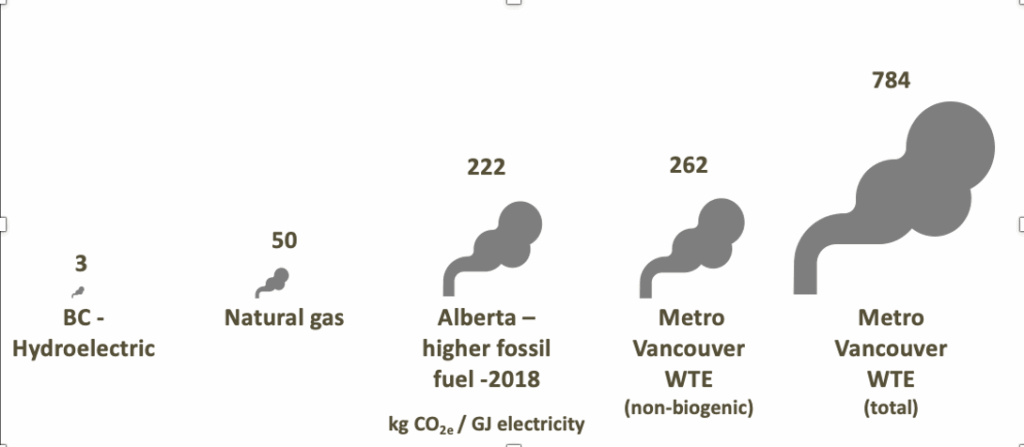
Comparing incineration to coal, oil, gas and other forms of energy production can be seen in this chart from a study by Dr. Neil Tangri.[3]
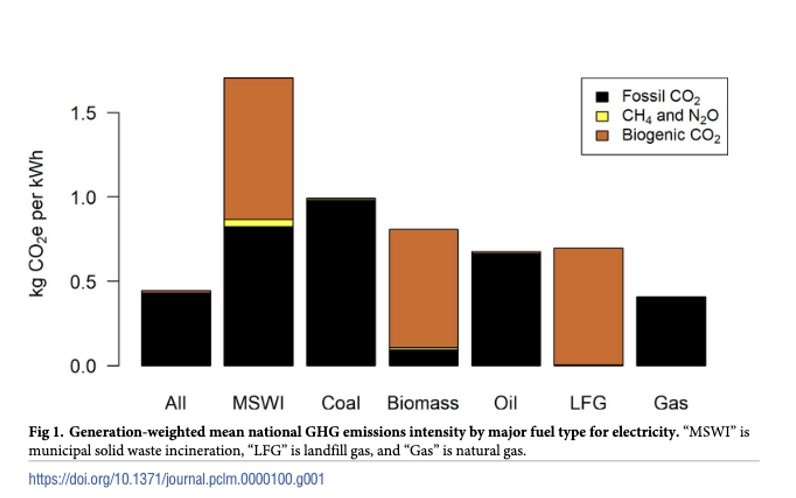
Of note, the study found “that incinerators emit more greenhouse gas emissions per unit of electricity produced (1707 g CO2e/kWh) than any other power source (range: 2.4 to 991.1 g CO2e/kWh). They also emit more criteria air pollutants than replacement sources of energy, such as natural gas.”
In addition, incinerators only capture some of the energy in a product as the system is fairly inefficient. (Note the province requires an incinerator to be 60% efficient in order to qualify as recovery. The Metro Vancouver facility is under that efficiency level so it is classified as a disposal method). The bigger issue is that incinerators waste more energy than they produce, primarily because what we incinerate needs to be replaced by new products. Extracting virgin materials from the earth, and manufacturing and processing these into new products to replace the ones incinerated uses up tremendous amounts of energy compared to reusing or recycling what we already have.
[1] Hogg, Dominic “A Changing Climate for Energy from Waste?” Friends of the Earth, March 5, 2006.
[2] David Suzuki Foundation et al., “Incineration of Municipal Solid Waste -Impact on Global Warming”. http://www.durhamenvironmentwatch.org/Incinerator Files/FS1climate_change.pdf
[3] Tangri, N.(2023). Waste incinerators undermine clean energy goals. https://journals.plos.org/climate/article/authors?id=10.1371/journal.pclm.0000100
5 What is getting burned?
While proponents often say the facilities are for non-recyclable material, in reality it is for materials that did not get recycled. Metro Vancouver waste audits show that the top three materials in waste are compostable organics, plastic and paper. [1] Other Metro Vancouver materials show that 80% of the materials could have been avoided, recycled or composted using current systems.[2]
Figure 1 Metro Vancouver waste composition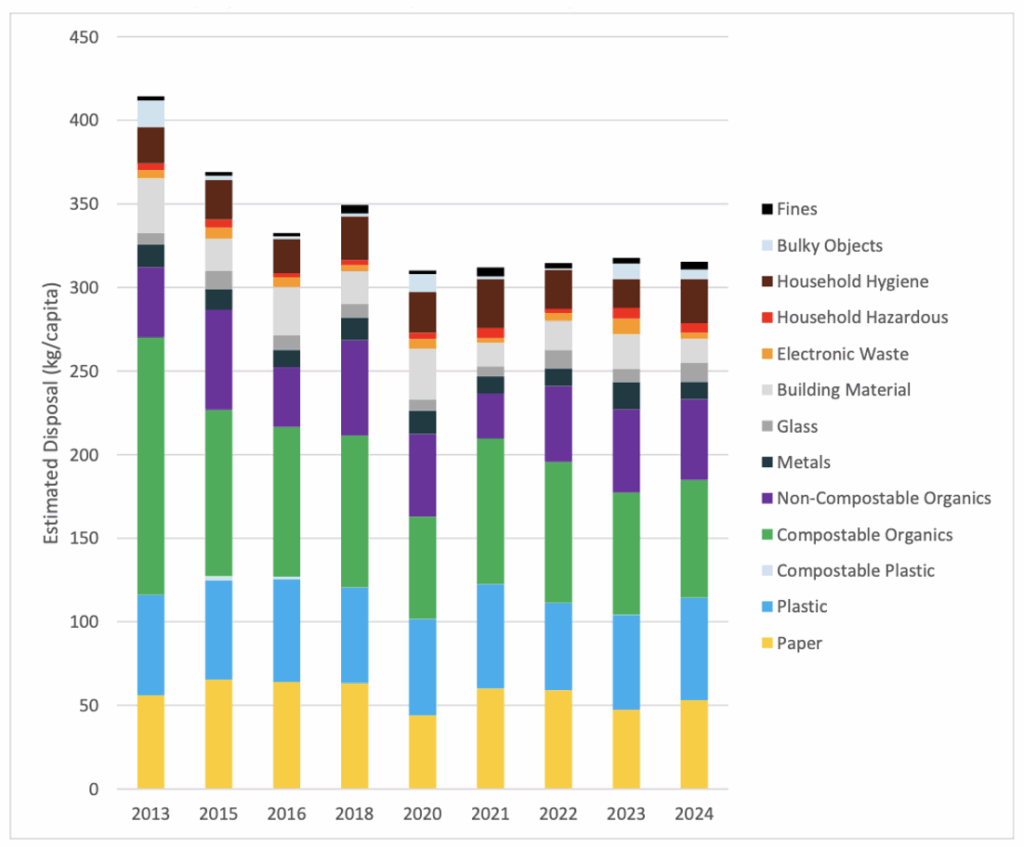
As the Province of BC has committed to adding other products to the Recycling Regulation, that will increase the number of items that can then get recycled such as mattresses, boxsprings, propane tanks and other forms of hazardous waste and more types of batteries in this current phase. They have also committed to developing system for textiles, construction and demolition materials and more. The province ais also looking at producer responsibility for paper and packaging materials coming from the institutional, commercial and industrial sector so that what goes in a blue box at home could also be recycled at work or schools in a consistent way. These types of programs are Extended Producer Responsibility (EPR) and making producers responsible can be a key step to designing out products that cannot be recycled. Allowing them to be incinerated removes that pressure to change.
In addition to noting most items could have been diverted from disposal, the other important fact to consider is that every load of waste being burned is different depending on what went in to the waste. It can include items with cadmium, mercury, lead and a host of other elements. Given that we do not know what goes into each load, we cannot know precisely what is coming out – but every atom entering the system exits in some form, whether as ash, dust and airborne pollutants.
[1] Dillon Consulting(2025). Metro Vancouver 2024 Full-Scale Waste Composition Study. Page ii. https://metrovancouver.org/services/solid-waste/Documents/full-scale-waste-composition-study-2024.pdf
[2] Metro Vancouver (2024). Handouts for Idea Generation Phase. https://metrovancouver.org/services/solid-waste/Documents/waste-prevention-reduction-idea-generation-supporting-documents.pdf
6 Will incinerators make waste disappear?
For every five truckloads of waste burned, four truckloads are pumped into the atmosphere and one remains as toxic ash, which still must be carefully stored or landfilled.[1] For the Metro Vancouver incinerator, on average 17% of the waste comes out as bottom ash and 4% as the extremely toxic fly ash.[2] It is very expensive to manage this material properly and it means that landfills are still needed to handle the ash.
Concerningly Metro Vancouver has been experimenting with adding the bottom ash into concrete at the cement kilns. This means that there is no way to trace where this material goes and if there are any environmental consequences from leaching of chemicals.
Every atom going into the incinerator comes out -either in the ash or in the air, sometimes in the form of new chemicals, including dioxins, heavy metals, halogenated organic compounds, PFAS, microplastics and nanoparticles.[3]
The 80% of the waste that goes into the air is why incinerators are essentially landfills in the sky. 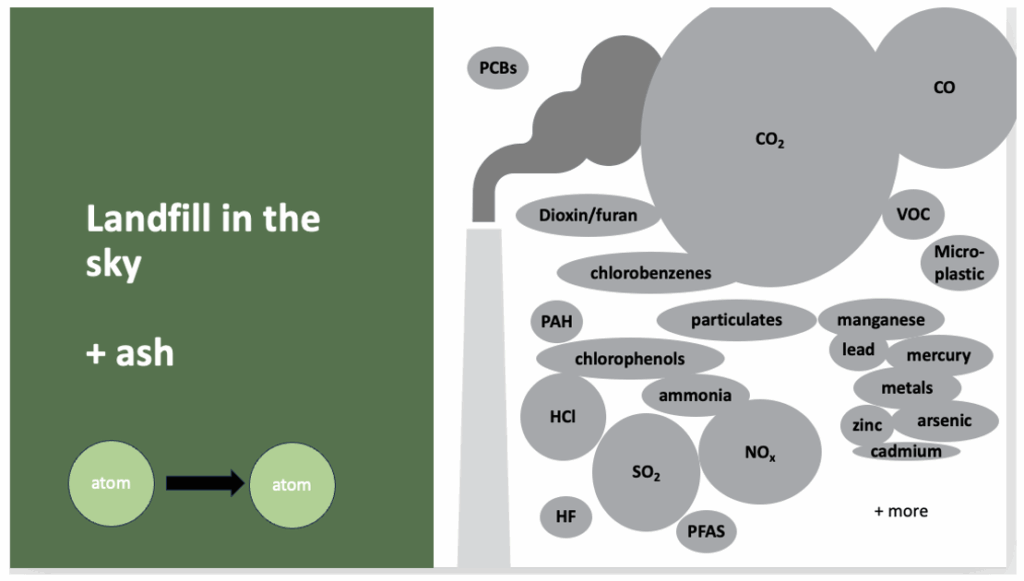
[1] AECOM, “Management of Municipal Solid Waste in Metro Vancouver –a comparative analysis of options for management of waste after recycling”, June 2009.
[2] Zero Waste BC (2023). Metro Vancouver – A Case Study on Waste Management Methods. https://drive.google.com/file/d/19oum89-TgC7Ab9-1C1IW2qFyVA7uOjyU/view
[3] Jelinek, N. et al. for IPEN and Arnika (2024). Waste incineration and the environment. Accessed at https://arnika.org/en/publications/waste-incineration-and-the-environment.
7 What about landfills?
Landfills emit methane, a very powerful type of greenhouse gas. It forms when organic material breaks down without oxygen (which is different than composting where it is important to rotate the compost to add oxygen). This is why it is so important to keep organics out of the waste by preventing food waste and composting the organics. Canada has introduced tighter standards for landfills requiring the large ones to collect landfill gas to reduce the climate impact. In BC many communities have rolled out organics collection services and composting systems. BC also has made more strict standards for landfills. While landfills still have an environmental impact, they are a better option for disposal than incineration which is why it is above incineration on the Zero Waste Hierarchy. Landfills are less expensive than incineration. In addition, as waste is reduced, there is no need to fill a landfill to its maximum allowable amount each year. When waste is reduced, that saves the landfill space for future years, extending its lifespan.
8 How should we manage waste?
A focus on Zero Waste approaches to waste and resource management, like reduction, reuse, repair, refill, recycling and composting, should be the priority for cost-effective and safer options that generate jobs while protecting the climate and the environment. The BC Business Case for Zero Waste showed Zero Waste to be the best option for managing materials.[1] The Environmental Life Cycle Analysis of Waste Management Strategies with a Zero Waste Objective looking at Metro Vancouver had the same conclusion.[2]
Zero Waste actions can take many forms. Ideally the Province follows through on its commitment to develop and implement a Circular Economy Strategy (part of the Clean BC plan). This would meet the demands from local governments through two Union of BC Municipality resolutions (calling for a Zero Waste Strategy –2017 and a Circular Economy Strategy -2021). BC is currently the only province without a comprehensive plan to address solid waste. Our A Zero Waste Agenda for BC provides suggestions of what this could include. Further ideas from First Nations, local governments and environmental groups can be seen here in the What We Heard report from our engagement with these groups.
At the municipal level, there are many ways to reduce waste and which ones a municipality chooses to do will depend on where they are starting from. Our Municipal Toolkit is a comprehensive suite of options from which to choose. It starts with developing a plan by bringing the community together. Climate Caucus offers a handbook on circular economy and zero waste to help local elected officials drive change.
In 2022 the UN declared March 31 as World Zero Waste Day going forward signifying the momentum that zero waste solutions have.
[1] Hood, I. for BC Ministry of Environment. Zero Waste Business Case. https://www2.gov.bc.ca/assets/gov/environment/waste-management/industrial-waste/industrial-waste/zero_waste_business_case_draft.pdf
[2] Morris, J. (2009). Environmental Life Cycle Assessment of Waste Management Strategies with a Zero Waste Objective. https://srmginc.com/images/LCA-and-Zero-Waste-Strategy-for-Metro-Vancouver-Region.pdf
9 Can incineration be part of a Zero Waste Strategy?
No, incinerators waste resources and undermine recycling and reduction efforts. Put or pay contracts where the supply of waste needs to be guaranteed are particularly problematic.
Metro Vancouver reports that 80% of the materials in the waste could have been avoided, recycled, or composted using existing systems.[1] Burning these materials to generate electricity discourages much needed efforts to conserve resources and reduce packaging and waste, and also undermines energy-conserving practices such as recycling and composting.
Moreover, waste is not and should not be fuel. Aside from the toxic chemicals released when burning waste, using waste as fuel creates a never-ending demand for waste. In effect, incineration removes incentives for waste minimization, and creates incentives to generate more waste.
In the Zero Waste hierarchy, the emphasis should be on rethinking our systems that result in waste and reducing our material use, followed by reusing, repairing and extending the life of existing products, recycling and composting. Using waste as fuel, even under the guise of “recovery,” undermines the efforts for more sustainable and preferable waste management options, which is why it is the last rung of the hierarchy – unacceptable.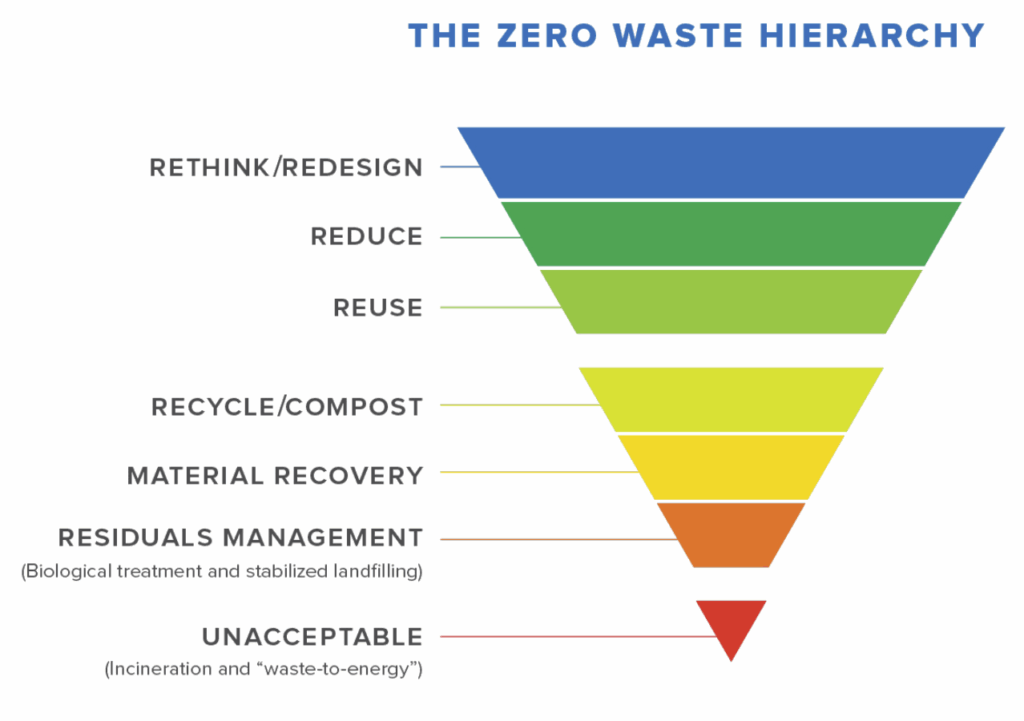
Incinerators burn many valuable resources that can be recycled and composted, and incinerators compete for the same materials as recycling programs. Because of the extremely high costs of constructing and operating an incinerator, spending taxpayer money for an incinerator means that there are significantly less funds to invest in the more cost-effective reduction, recycling and composting solutions.
[1] Metro Vancouver (2024). Handouts for Idea Generation Phase. https://metrovancouver.org/services/solid-waste/Documents/waste-prevention-reduction-idea-generation-supporting-documents.pdf
10 But they use incineration in Europe?
The EU has a significant number of incinerators, in part due to a policy that supported them over landfills in the past. However, the failure of that policy to drive waste reductions and the other negative impacts has driven a policy shift. This Zero Waste Europe blog post shows how that shift away from incineration is taking place. Since 2020, there has been a moratorium on EU financing for incinerators and incineration will be more expensive in the future due to fees on carbon in emissions trading systems.
With higher targets for organics management, recycling, waste reduction and waste diversion in the EU, there is now incineration overcapacity, meaning there are more incinerators than waste available for burning. This overcapacity has led to waste importation in Germany, the Netherlands, United Kingdom, Sweden, Denmark and Spain. It has also led to an interest by incineration companies in expanding to Canada.
Many countries on the other hand, are embracing Zero Waste and are investing in long-term waste management strategies, including shutting down their incinerators. Hundreds of municipalities in Italy and Spain have now set Zero Waste as a goal with many success stories.[1] Capannori, Italy has one of the highest municipal recycling rates in Europe as one of the first to embrace zero waste to face the threat of an incinerator. This zero waste town exemplifies how strong policy decisions and community participation can achieve groundbreaking results.
[1] Zero Waste Europe (2025). The State of Zero Waste Municipalities -5th edition. https://zerowasteeurope.eu/library/the-state-of-zero-waste-municipalities-5th-edition/.
11 What are the health and environmental impacts?
Incineration in all its forms creates incredibly toxic air and ash pollution. This includes pollutants such as particulate matter, sulphur dioxide and nitrogen oxides. The burning of plastics and other combustible materials creates very toxic dioxins and furans. These are extremely toxic substances that accumulate in the soil and in our bodies. Dioxins are extremely harmful even at very small levels, especially for nursing infants and toddlers.
Even the most “advanced” incinerators release thousands of pollutants that contaminate our air, soil and water. Many of these pollutants enter the food supply and concentrate up through the food chain. The most sophisticated filtration systems available cannot remove all of these toxic substances and we can’t safely predict the toxins released because every load of garbage is different. Emissions levels reported for existing incinerators are based on ideal computer modelling. Real world emissions testing is very limited and in many cases, including at Metro Vancouver’s incinerator, happens only a few times per year (or less for dioxins). For example one of the newest incinerators in North America, at the Durham York Energy Centre, releases dioxins and at some points in time, has released dioxins at levels nearly 14 times the allowable limit.[1] A recent study near three European incinerators found toxic dioxins and other accumulating ‘forever chemicals’ in vegetation and agricultural goods, including eggs.[2]
Incinerators are major emitters of cancer-causing dioxins and furans.[3] Studies show a significant increase in the risk of dying from cancer in areas near incinerators.[4] Communities around incinerators are highly vulnerable. Incinerator pollution control devices are not fool-proof and there are many examples of failures of facilities even with “state-of-the-art” pollution control devices. Even modern pollution control devices such as air filters do not prevent the escape of many hazardous emissions such as ultra-fine particles.[5] These particles can be lethal, causing cancer, heart attacks, strokes, asthma, and pulmonary disease. Numerous studies by Toxicowatch measuring dioxins, furans and other forms of pollution around incinerators in the EU show higher than expected levels of pollution, even from newer facilities.[6]
Emissions of mercury (a known neurotoxin) is also a major concern. Incinerator emissions are also a source of particulate matter—tiny particles of dust that can lead to decreased lung function, irregular heartbeat, heart attacks, and premature death. A public health impacts report states that modern incinerators in the EU are a major source of ultra-fine particulate emissions.[7] In 2017, another study revealed that particulate matter contributed to over 4 million premature deaths globally in 2015.[8]
Aside from toxic air emissions, incineration technologies produce highly toxic by-products.
Pollutants captured by air filtering devices are transferred to the facility’s by-products, such as fly ash, bottom ash, boiler ash/slag, and wastewater treatment sludge that are then released into the environment.[9]
Figure 2 Potential Pollutants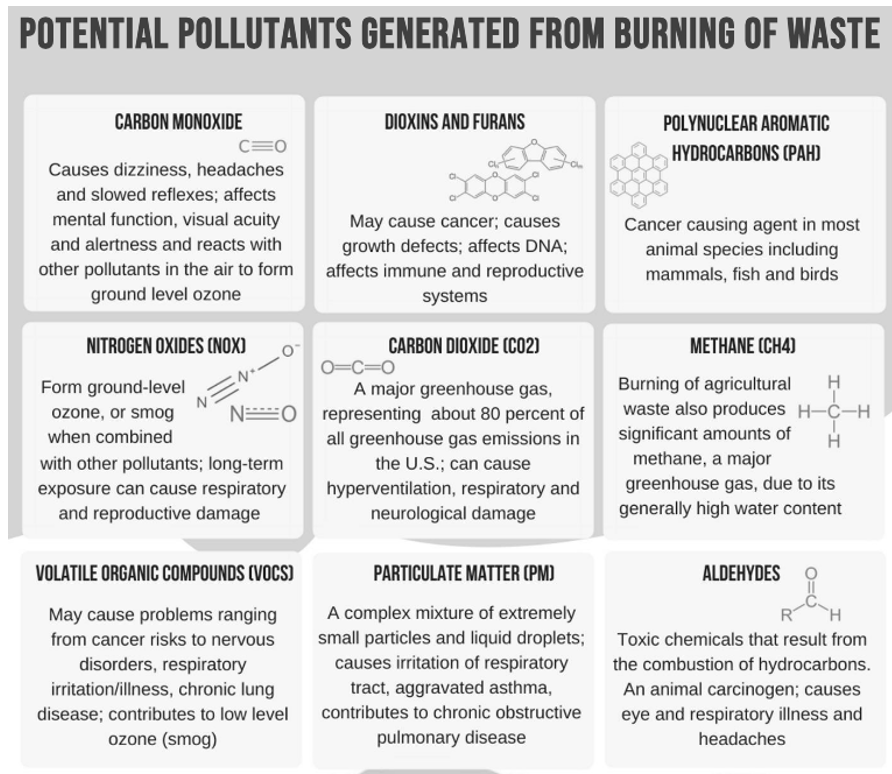
Figure 2 sourced from GAIA’s 2018 report Incinerators In Trouble.
[1] Noor Javed, June 2016 “Durham grapples with incinerator’s ‘alarming’ emissions” – The Toronto Star
[2] Zero Waste Europe, (2022). “The True Toxic Toll: Biomonitoring of incineration emissions“
[3] Health Canada. Fact Sheet: Dioxins and Furans. https://gost.tpsgc-pwgsc.gc.ca/Contfs.aspx?ID=66&lang=eng
[4] Waste Incineration and Public Health (2000), Committee on Health Effects of Waste Incineration, Board on Environmental Studies and Toxicology, Commission on Life Sciences, National Research Council, National Academy Press, pp. 6-7
[5] Howard, C.Vyvyan, Statement of Evidence, Particulate Emissions and Health, Proposed Ringaskiddy Waste-to-Energy Facility, June 2009.
[6] Toxicowatch TX Reports, Articles and Abstracts. https://www.toxicowatch.org/blank-1
[7] Howard, C.Vyvyan, Statement of Evidence, Particulate Emissions and Health, Proposed Ringaskiddy Waste-to-Energy Facility, June 2009.
[8] Health Effects Institute. 2017. State of Global Air 2017. Special Report. Boston, MA:Health Effects Institute. Downloadable from: https://www.stateofglobalair.org/sites/default/files/SoGA2017_report.pdf.
[9] Römbke, J., et al. Ecotoxicological characterisation of 12 incineration ashes using 6 laboratory tests. Waste Management, 2009.
12 How effective are environmental standards, regulations and reporting requirements to monitor and control emissions from incinerators?
Operators will often say that they meet the emissions standards but what is not stated is that often those standards are low or out of date. Dr Douw Steyn, a professor emeritus and expert on air quality conducted a review of air quality guidelines and testing protocols. This review showed that the 2011 standard to which BC holds the incinerator is no longer best practice. In fact both the EU and the US have updated their recommended levels for both new and existing facilities.
What is also not mentioned is that the testing requirements are also weak. For the most toxic pollutant, dioxins and furans, the testing requirement is only for one of the three boilers once a year at a time of the operator’s selection under ideal operating conditions (they are not allowed to test during start up, shutdown or malfunctions). There was a biomonitoring study[1] done near an incinerator in Brooks Oregon which caused regulators to require continuous testing for most key pollutants. The operator closed the facility after these were announced. The EU now requires monitoring of dioxins during all operating times including start-ups. This is important as these are the times when these compounds are more likely to form and as persistent pollutants, they do not disappear. We outlined these concerns in our feedback to the provincial regulator on Metro Vancouver’s Operational certificate.
Aside from air emissions, soil monitoring is also important, especially as agricultural products an be a vector for persistent organic pollutants. Although a consultants report recommended ongoing soil monitoring after an initial study after the incinerator was built, no further testing was done.
While the regulations for the waste incinerator are weak, the ones for the two cement kilns in BC burning a growing amount of waste are even weaker. These are overseen by Metro Vancouver and not the province.[2], [3] This is also of concern given the three facilities are all within a 10 km radius and many of the pollutants accumulate. The cumulative effects should be analyzed.
[1] National Library of Medicine (2024). Putting biomonitors to work: native moss as a screening tool for solid waste incineration. https://pmc.ncbi.nlm.nih.gov/articles/PMC11543719/
[2] Metro Vancouver (May 2025). Permit GVA0154 for Lafarge cement manufacturing plant. https://metrovancouver.org/services/environmental-regulation-enforcement/air-quality-regulatory-program/AirQualityPermits/0154%20-%20Lafarge%20Canada%20Inc.%20-%20Air%20Quality%20Permit%20Amendment%20-%20Issued%20May%209,%202025.pdf
[3] Metro Vancouver (Jan 2010). PermitGVA0175 and amendment. https://metrovancouver.org/services/environmental-regulation-enforcement/air-quality-regulatory-program/AirQualityPermits/0175_Lehigh_Hanson_Materials_-_Permit_Amendment_Issued_2010-01-01.pdf
13 Is waste incineration a clean and renewable energy source?
In fact, it is neither. The last question noted how this is not a clean solution. As for renewable, renewable energy is defined as energy created from natural processes that do not get depleted, such as wind, wave or solar energy. Municipal waste is non-renewable, consisting of discarded materials such as plastic, metal and glass that are derived from finite natural resources (plastics for example are made of fossil fuels) or in some cases, like paper, resources such as forests that are being cut down at unsustainable rates.
Providing subsidies or incentives for incineration encourages local governments to destroy materials, rather than investing in environmentally sound and energy conserving practices such as reduction, repair, reuse, sharing, recycling and composting.
But not only is “waste-to-energy” incineration non-renewable, it also takes investments away from real renewable energy solutions, making it a waste of energy. The world needs to shift away from fossil fuel use toward a massive uptake of real renewable energy, such as wind and solar, with a decrease in energy use, in order to prevent the worst impacts of climate change.
Currently, incinerator companies are deceptively marketing “waste-to-energy” incineration as “renewable energy.” Funds put into this false approach signify a lost opportunity for the development of real renewable energy solutions.
14 Is waste to energy cost effective?
No, this is the most expensive way to manage waste. The case study on Metro Vancouver noted that this was the most expensive way to manage waste and that was only factoring in the operating costs. Add on the increasing amount of capital projects to maintain the incinerator, this will only become more costly.
All WTE incinerators are prohibitively expensive. Incinerators are the most expensive method to generate energy and to handle waste, while also creating a significant economic burden for host cities. A recent estimate for Ottawa had capital costs to build a mass burn incinerator at $497 million to $862 million with annual operating and maintenance of $47 million.[1]
Incinerators are capital intensive and often rely on subsidies to proceed.[2] The amount of federal, provincial and municipal funding that was wasted trying to prop up failed ventures is noted in our Cautionary Tales , a look at the poor outcomes for Canadian municipalities and taxpayers from pursuing waste to energy.
There are many examples of municipalities that have ended up in debt because of incinerators. In 2011, Harrisburg, Pennsylvania became the largest US city to declare bankruptcy, and the financial blame rests on the staggering debt payments for upgrades to the city’s incinerator.[3] Detroit taxpayers have also spent over USD 1.2 billion in debt service payments from constructing and upgrading the world’s largest waste incinerator.[4] As a result, residents have had to pay high trash disposal fees of over USD 150 per ton. The city could have saved over USD 55 million in just one year if it had never built the incinerator. Numerous reports highlight zero waste actions as far more cost effective.[5], [6], [7]
[1] Ottawa (June 2025). Council approves exploration of long-term waste management solutions. https://ottawa.ca/en/city-hall/city-news/newsroom/council-approves-exploration-long-term-waste-management-solutions
[2] Jelinek, N. et al. for IPEN and Arnika (2024). Waste incineration and the environment. Accessed at https://arnika.org/en/publications/waste-incineration-and-the-environment.
[3] Last, J. -CBS News (Oct 27, 2011). Municipal folly bankrupts a state capital. https://www.cbsnews.com/news/municipal-folly-bankrupts-a-state-capital
[4] Guyette, Curt, Fired Up: Detroit Incinerator’s Long Simmering Opposition, Detroit Metro Times, April 2008. http://www.metrotimes.com/editorial/story.asp?id=12748
[5] Seldman, Neil, Recycling First -Directing Federal Stimulus Money to Real Green Projects, E Magazine, 2008
[6] Hood, I. for BC Ministry of Environment. Zero Waste Business Case. https://www2.gov.bc.ca/assets/gov/environment/waste-management/industrial-waste/industrial-waste/zero_waste_business_case_draft.pdf
[7] Zero Waste BC (2023). Metro Vancouver – A Case Study on Waste Management Methods. https://drive.google.com/file/d/19oum89-TgC7Ab9-1C1IW2qFyVA7uOjyU/view
15 What about jobs?
Incinerators require huge capital investments, but they offer relatively few jobs when compared to the real “green jobs “for reduction, repair, reuse, refilling, sharing, recycling and composting. A 2021 report found that remanufacturing creates almost 30 times as many jobs as landfills and incinerators, which increases to 50 times for recycling and over 200 times for repair.[1] The Closing the Loop report looked at the BC context and similarly found the potential for job creation with a zero waste agenda.
[1] GAIA (2021). Zero Waste and Economic Recovery -the Job creation Potentioal of Zero Waste Solutions. https://www.no-burn.org/wp-content/uploads/Jobs-Report-ENGLISH-1.pdf.
16 What about district energy?
District energy can be one solution for climate change but ONLY if it is connected to a renewable resource (not waste incineration). Renewable sources could be heat from waste water facilities, solar, wind or heat from the ground or air. It is also important to use as little energy as possible first through sound design of the buildings.
17 What is the lifespan of an incinerator?
While there is much discussion of lifespans of landfills, it is important to note that incinerators also have a lifespan. A study of incinerators in the US showed they were closing at an average age of 25 years mainly due to issues such as insufficient revenue or the inability to afford required upgrades.[1] As incinerators age, they tend to break down more often and also to release more emissions. The Metro Vancouver incinerator was built in 1988 and is now 37 years old. It is far past its operating lifespan.
[1] Energy Justice (2025). FACT SHEET: Trash Incinerator Closures 2000-2024. https://www.energyjustice.net/incineration/closures.pdf .
18 Where do incinerators get situated?
Disadvantaged communities are disproportionately burdened. These communities are more vulnerable to being targeted as sites for new incinerators.[1] Almost 80 percent of incinerators in the U.S. are located in environmental justice communities – defined as communities of colour and/or low income.[2] In fact, the documentary Burning Injustice, about the impacts of one of the last incinerators in California on the community nearby, highlighted the Cerrell report written for the state, which specified which communities would be the best to target based on being the least likely to resist.
The Emerald incinerator in Brampton Ontario’s Peel region, which has a planned expansion, is in an area already burdened with significant air pollution related to highway traffic and industrial pollution, including pollution from a gas-fired power plant. The residents in the area are more likely to be racialized, experiencing precarious employment and have lower incomes than the Ontario average.[3],[4] This continues the pattern of placing these facilities and their toxic burdens next to racialized and/or lower income communities. The Report from the Commissioner of Health Services for the Region of Peel notes, “Health and sociodemographic data of the communities that live near the EEFW facility demonstrates the potential for worsening health disparities.”
[1] Mohai, Paul “Reassessing Racial and Socioeconomic Disparities in Environmental Justice Research,” May, 2006, Demography, 43 (2), 383-399
[2] Tishman Environment and Design Centre (2019). U.S. Municipal Solid Waste Incinerators: An Industry in Decline. https://www.no-burn.org/u-s-municipal-solid-waste-incinerators-an-industry-in-decline/.
[3] Environmental Defence & Ontario Public Health Association, 2020, Clearing The Air
[4] Region of Peel, Census Information Hub – https://census-regionofpeel.hub.arcgis.com
19 Who is supporting incineration and why?
Aside from the incineration industry sales people, the petro-chemical industry and organizations such as the American Chemistry Council, are promoting incineration, especially “chemical recycling” instead of supporting plastics recycling programs and designing plastics and packaging to be reusable or recyclable. Petro-chemical industry support for incineration removes any producer responsibility from plastics manufacturers and users and shifts the burden of end of life management to municipalities. The fossil fuel industry plans to make up for lost gasoline sales with an increase in plastic production.[1]
In Canada, lobby groups include the Chemistry Industry Association of Canada and the Canadian Plastics Industry Association.[2] In the past these groups have funded other organizations to mask their presence which have included the defunct Canada Energy for Waste coalition and the Canadian Resource Recovery Council.
Other lobbyists include the cement industry which is attempting to rebrand burning waste instead of other fossil fuels as greener. Here in BC and elsewhere, this is being led by Geocycle, part of the Holcim group.
[1] Forbes(2020). Why The Oil Industry’s $400 Billion Bet On Plastics Could Backfire. https://www.forbes.com/sites/scottcarpenter/2020/09/05/why-the-oil-industrys-400-billion-bet-on-plastics-could-backfire/.
[2] Standing Committee on Environment and Sustainable Development (Apr 3, 2019). Evidence provided by Joe Hruska, Canadian Plastics Industry Association. https://www.ourcommons.ca/DocumentViewer/en/42-1/ENVI/meeting-149/evidence
20 Who is resisting incineration?
A group of concerned organisations across Canada came together when a report commissioned by Environment and Climate Change Canada was released. This report was unusually pro-incineration because it had failed to include Zero Waste as an alternate strategy, include biogenic emissions and look at the trends of regulation and systems towards decreased landfill methane and stronger waste prevention systems. Our coalitions’ deeper dive on the analysis resulted in the Stopping Waste to Energy in Canada campaign including four reports, a webinar series and a Sign On statement supported by almost 50 organizations.
Many organizations came together to prevent a new incinerator being built by Metro Vancouver when it was included in the 2011 solid waste management plan. That included the Fraser Valley Regional District, City of Nanaimo, Village of Lions Bay, City of Vancouver, District of North Vancouver, City of Port Moody, District of Maple Ridge (opposed to mass burn), Village of Harrison Hotsprings, District of Mission, City of Abbotsford, BC Sustainable Energy Association. Vancouver Board of Trade, and Vancouver and District Labour Council. Others that voiced opposition were Wilderness Committee, Ridge Meadows Recycling Society, Burke Mountain Naturalists, Tri-City Green Council, New Westminster Environmental Partners, Village Vancouver, Langley Field Naturalists, Quayside Village Cohousing and numerous individual citizens.[1]
That resulted in Metro Vancouver halting its plans in 2015 but not before it had spent $4.5 million on pursuing waste to energy.[2] Mr. Burns, the mascot, joined the campaigning.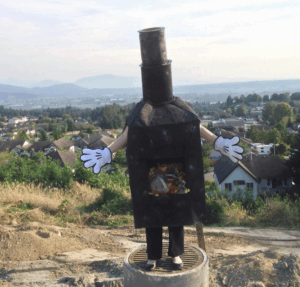
Now several organizations including Zero Waste BC, Zero Waste Canada, the Canadian Association of Physicians for the Environment BC, Doctors for Planetary Health – West Coast, GAIA, and For Our Kids, Burnaby have called for the existing incinerator to be phased out. Join the many local citizens and organizations in our petition to shut down the Metro Vancouver incinerator.
Many others also are concerned about the rising costs to keep incinerating waste in Metro Vancouver, especially when there are less expensive, less harmful alternatives.
[1] Metro Vancouver files on feedback to 2010 Solid Waste Management Plan.
[2] Abbotsford news (2015). Metro Vancouver halts plan to build new garbage incinerator. https://www.abbynews.com/news/metro-vancouver-halts-plan-to-build-new-garbage-incinerator-1738276.
